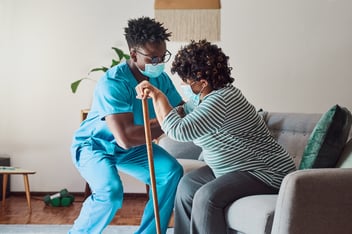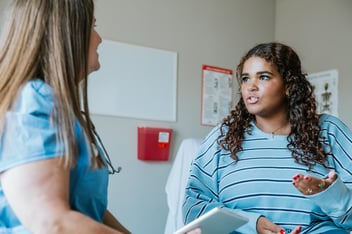The Importance of Chaperones in Sensitive Medical Exams

Tamara Johnson advocates for using medical chaperones during sensitive exams to help ensure trust, preserve patient dignity, and support clinicians.
In my years as a risk management consultant, I've come to appreciate how trust and transparency form the foundation of the physician–patient relationship. That’s why I strongly recommend using chaperones during “sensitive” patient exams and procedures.
Having a chaperone present enhances trust, preserves patient dignity, and supports both clinicians and patients.
Key Takeaways:
- Sensitive medical exams, especially those that involve private areas, require careful handling.
- Chaperones serve as an essential safeguard and can help prevent legal complications as well as alleviate patient anxiety.
- Only trained healthcare professionals should serve as medical chaperones.
- An effective chaperone policy includes written guidelines and clear communication with patients about their options.
When and Why Chaperones Are Critical
Sensitive medical exams require careful handling to maintain trust. A sensitive exam can be defined as an exam or procedure that involves any private area, regardless of age or gender. These may include physical or visual examinations.
It’s important to remember that a sense of invasiveness can vary by individual. In addition, other exams that require the patient to be in a state of undress or require close physical contact can also benefit from another medical professional in the room.
One of the most significant reasons I advocate for chaperones in these exams is to prevent misunderstandings or potential legal complications.
With growing concerns about medical misconduct, chaperones serve as an essential safeguard, providing an unbiased witness who can attest to the nature of the examination. Some states report high rates of disciplinary action related to sensitive exams, making chaperone policies even more critical.
In fact, several states have specific laws or regulations concerning the use of chaperones during intimate exams or that outline the types of exams for which chaperones should be considered. While federal mandates don't exist, I see a growing trend toward adopting stronger chaperone policies in the medical community.
The Role of a Medical Chaperone
A chaperone is more than just a passive observer; they play a crucial role in fostering a comfortable and secure environment during sensitive medical exams or procedures.
Remember, medical exams can feel intrusive or vulnerable for many patients. Having a chaperone present can alleviate anxiety by offering more professionalism and accountability.
I've seen firsthand how their presence reassures patients and reinforces accountability in the healthcare setting.
Medical chaperone responsibilities include:
- Acting as a safeguard for both patients and clinicians
- Staying familiar with examination procedures
- Ensuring ongoing patient consent throughout the exam
- Maintaining respect for patient dignity and confidentiality
- Providing reassurance when necessary
- Ultimately, verifying and validating the interactions that take place during a medical exam
Additionally, chaperones can assist with medical procedures, equipment, documentation, or other aspects of the exam. This assistance not only streamlines workflow but also ensures exams run smoothly, benefiting both clinicians and patients.
Who Should—and Should Not—Serve as a Chaperone
Ensure that trained healthcare professionals serve as chaperones, including:
- Licensed medical doctors (MD/DO)
- Nurse practitioners and physician assistants
- Registered nurses, LPNs, and medical assistants
- Certified nursing assistants and scribes
On the other hand, best practices mandate that family members should not take on this role. They cannot be a neutral observer because of their relationship with the patient. This does not suggest a family member can't stay in the room. However, a trained chaperone should be present.
An Effective Chaperone Policy
If there's one lesson I've learned, it’s that having an effective chaperone policy benefits everyone involved.
Components of a chaperone policy include:
- Establishing formal, written guidelines on the use of chaperones
- Training clinicians and employees in proper chaperone procedures
- Informing patients that they can request a chaperone for any physical exam
- Ensuring chaperones are available for all sensitive exams
- Offering private discussions to address patient concerns
- Documenting the presence (or refusal) of chaperones
Final Thoughts
In my experience, chaperones are a critical safeguard, ensuring patient dignity, professional integrity, and legal protection.
That said, I recognize that implementing chaperone policies can be challenging. Not all medical practices have access to dedicated chaperones, and staffing shortages and budget constraints can make consistent implementation difficult.
If you’re interested in using chaperones in your practice but facing some of these issues, consider training nonclinical team members for the role, such as scribes.
And be sure to check out the resources below for more information and guidance.
Curi Resources
Curi clients, sign in to our Risk Solutions Resource Catalog to access related resources:
- Policy: Medical Chaperone
- The Importance of Chaperones in a Medical Setting
- Risk Management Guide: Sexual Boundaries and Abuse
If you have questions about this topic, please call 800-328-5532 to speak with one of Curi Advisory's Risk Solutions Consultants.
References:
SHARE THIS POST
About the Author

Tamara has more than 38 years of experience in the healthcare industry, working with medical professional liability (MPL) insurance carriers, hospitals, and outpatient healthcare facilities. She has been employed with Curi for over 22 years and has worked in the MPL space for over 28 years.








.jpg?width=352&name=iStock-1770754397%20(1).jpg)
Comments